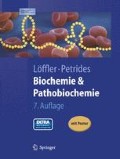Zusammenfassung
Eine entscheidende Funktion der Lipide ist der Aufbau sämtlicher zellulärer Membranen, womit erst die Existenz von Zellen, deren Inneres gegen die Außenwelt abgeschirmt ist, ermöglicht wird. Für diese Funktion sind amphiphile Lipide wie Phospholipide und Sphingolipide besonders geeignet, die neben den für Lipide typischen hydrophoben Alkanketten auch über hydrophile, polare und geladene Gruppen verfügen und somit die für alle zellulären Membranen typischen Doppelschichten ausbilden können. Auch Cholesterin ist ein essentieller Bestandteil aller tierischer Membranen.
Access this chapter
Tax calculation will be finalised at checkout
Purchases are for personal use only
Preview
Unable to display preview. Download preview PDF.
Literatur
Original- und Übersichtsarbeiten
Bevers EM, Comfurius P, Dekkers DWC, Zwaalr FA (1999) Lipid translocation across the plasma membrane of mammalian cells. Biochim Biophys Acta 1439: 317–330
Bodzioch M, Orso E, Klucken J, Langmann T, Bottcher A, Diederich W, Drobnik W, Barlage S, Buchler C, Porsch-Ozcurumez M, Kaminski WE, Hahmann HW, Oette K, Rothe G, Aslanidis C, Lackner KJ, Schmitz G. (1999) The gene encoding ATP-binding cassette transporter 1 is mutated in Tangier disease. Nat Genet 22: 347–351
Brown MS, Goldstein JL (1999) A proteolytic pathway that controls the cholesterol content of membranes, cells, and blood Proc. Natl Acad Sci USA 96: 11041–11048
Brown MS, Jin YE, Rawson RB, Goldstein JL (2000) Regulated intramembrane proteolysis: a control mechanism conserved from bacteria to humans. Cell 100: 391–398
Fielding CJ, Fielding PE (2000) Cholesterol and caveolae: structural and functional relationships. Biochim Biophys Acta 1529: 210–222
Flower DR (1996) The lipocalin protein family: structure and function. Biochem J 318: 1–14
Funk CD (2001) Prostaglandins and leukotrienes: advances in eicosanoid biology. Science 294: 1871–1875
Goldstein JL, Brown MS (2001) The cholesterol quartett. Science 292: 1310–1314
Hla T, Lee M, Ancellin N, Paik JH, Kluk MJ (2001) Lysophospholipids: receptor revelations. Science 294: 1875–1878
Huwiler A, Kolter T, Pfeilschifter J, Sandhoff K (2000) Physiology and pathophysiology of sphingolipid metabolism and signaling. Biochem Biophys Acta 1485: 63–99
Katso R, Okkenhaug K, Ahmadi K, White S, Timms J, Waterfield MD (2001) Cellular function of phosphoinositide 3-kinases: implications for development, immunity, homeostasis, and cancer. Annu Rev Cell Dev Biol 17: 615–75
Von Landenberg P, Von Landenberg C, Schölmerich J, Lackner KJ (2001) Antiphospholipid syndrome. Pathogenesis, molecular basis and clinical aspects. Med Klin 96 (6): 331–342
Osborne TF (2000) Sterol regulatory element binding proteins (SREBPs): Key regulators of nutritional homeostasis and insulin action. J Biol Chem 275: 32 379–32 382
Segrest JP, Jones MK, De Loof H, Dashti N (2001). Structure of apolipoprotein B-100 in low density lipoproteins. J Lipid Res 42: 1346–1367
Simons K, Ikonen E (2000) How cells handle cholesterol. Science 290: 1721–1726
Stahlhut M, Sandvig K, Van Deurs B (2000) Caveolae: uniform structures with multiple functions in signaling cell growth, and cancer. Exp Cell Res 261: 111–118
Willnow TE (1999) The low-density lipoprotein receptor gene family: multiple roles in lipid metabolism. J Mol Med 77: 306–315
Winder WW, Hardie DG (1999) AMP-activated protein kinase, a metabolic master switch: possible roles in Type 2 diabetes. Am J Physiol 277: E1 - E10
Editor information
Editors and Affiliations
Rights and permissions
Copyright information
© 2003 Springer-Verlag Berlin Heidelberg
About this chapter
Cite this chapter
Löffler, G. (2003). Stoffwechsel von Phosphoglyceriden, Sphingolipiden und Cholesterin. In: Löffler, G., Petrides, P.E. (eds) Biochemie und Pathobiochemie. Springer-Lehrbuch. Springer, Berlin, Heidelberg. https://doi.org/10.1007/978-3-662-06058-2_20
Download citation
DOI: https://doi.org/10.1007/978-3-662-06058-2_20
Publisher Name: Springer, Berlin, Heidelberg
Print ISBN: 978-3-662-06059-9
Online ISBN: 978-3-662-06058-2
eBook Packages: Springer Book Archive

